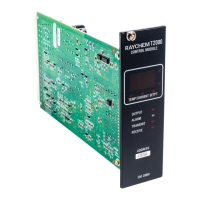50 | nVent.com
6.3 COMMON ALARMS—WHAT TO LOOK FOR
The CM 2000 and the CM 2000+ control modules have a wide range of alarming features that may be selectively enabled or disabled
to allow the monitoring and indication of trouble conditions. Described below are the different alarm conditions available on the
control module, their meanings, and possible causes.
Alarm Description Cause of Alarm
High TS 1/ TS
2 Temperature
This alarm will appear when the sensor
temperature exceeds the HIGH TS TEMP ALARM
temperature setting.
• Alarm temperature setting too close to maintain temperature
• Flow of hot product
• Steaming out lines
• Incorrect TRACER wiring
Low TS 1/TS 2
Temperature
This alarm will appear when the sensor
temperature decreases below the LOW TS TEMP
ALARM temperature setting.
• Alarm temperature setting too close to maintain temperature
• Flow of cold product
• Empty Pipe
• Damaged, wet, or missing insulation
• Heating cable not sized properly for the application or
damaged
TS 1/ TS 2
Failure
This alarm will indicate if a temperature sensor is
not operating properly. The temperature sensor
may fail due to an “open” or “shorted” condition.
• Incorrect or damaged field wiring - open leads or excessive
resistance, (either intermittent or continuous) may be due to
broken or damaged wires or loose terminals.
• Damaged or inoperative temperature sensors
Control TS
Failure
This alarms a failure of the temperature sensing
element designated as the control element by the
TS CONTROL MODE setting. The output switch
may be latched off until this failure is corrected.
• Incorrect or damaged field wiring - open leads or excessive
resistance (either intermittent or continuous) may be due to
broken or damaged wires or loose terminals.
• Damaged or inoperative temperature sensors
• The ATC signal from an ATC MASTER control module
is absent
High Current This alarms current levels that are greater than
the HIGH CURRENT ALARM setting for the
application.
• Alarm setting too close to normal operating current
• High in-rush current from “cold start” of self-regulating cable
• Damaged or partially shorted heating cable
• “As built” cable length is greater than design value
• Incorrect CURRENT TURNS RATIO setting
• Incorrect wiring
Low Current This alarms current levels that are less than the
LOW CURRENT ALARM setting.
• Alarm setting too close to normal operating current
• Low source voltage
• Damaged or inoperative heating cable
• Open connection - wiring problem
• SSR or contactor failure (open)
• Incorrect CURRENT TURNS RATIO setting
High GFI This alarms ground fault current levels which are
greater than the HIGH GFI ALARM setting.
• Alarm setting too close to normal leakage current
• Damaged cable insulation and/or moisture present
• Moisture in junction box
• Poor splice or termination
• Moisture provides conductive ground path which allows
ground fault current
GFI Trip This value sets the upper limit of allowable ground
fault leakage. Exceeding this limit will result in
the output switch being latched off and the alarm
activated to indicate a ground fault condition.
• Trip setting too close to normal leakage current
• Damaged cable insulation and/or moisture present
• Moisture in junction box
• Poor splice or termination
• Moisture provides conductive ground path which allows
ground fault current

